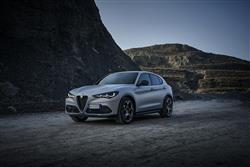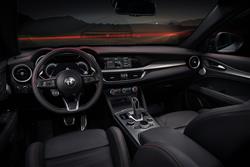Alfa Romeo Stelvio - ABC Leasing
WHY YOU SHOULDN'T PASS ON THE STELVIO(some text hidden)
By Jonathan Crouch
Ten Second Review word count: 61
This Stelvio model is, according to its maker, very much an Alfa Romeo first and an SUV second. That sounds promising, as does the fact that most of the engineering here is shared with the brand's well-regarded Giulia saloon. The result should be a premium mid-sized SUV well able to mix it with class favourites, especially in this lightly revised form.
Background word count: 154
Will any brand be able to resist the allure of the growing SUV market? It doesn't appear so. We live in a time when even Ferrari and Rolls Royce feel the need to produce such a thing, so it is perhaps surprising that it took Alfa Romeo quite so long to join this lucrative band wagon. Still, join it they did in 2017 with this car, the Stelvio, named after the famous European mountain pass. This was the car that the Milanese marque hoped would give it an important foothold in the profitable segment for premium mid-sized SUVs currently dominated by cars like BMW's X3, Jaguar's F-PACE, Audi's Q5, Volvo's XC60 and the Mercedes GLC. And the Stelvio has sold steadily in this segment since launch, hobbled only by an interior that from launch, lacked the quality to really rival other premium brand models. So that's been addressed as part of this light facelift.
Driving Experience word count: 369
There are no significant changes to this improved Stelvio beneath the bonnet - which is surprising given that most rivals are now offering various degrees of electrification. Still, thanks to perfect 50/50 weight distribution, Q4 all-wheel drive architecture, a best in class power-to-weight ratio and innovative engine and driver technologies, the Stelvio embodies everything a true Alfa Romeo should. Not only that, but this Italian contender remains one of the lightest mid-size SUVs in the sector thanks to lightweight body structure and a carbon fibre driveshaft. The suspension sees a double wishbone set-up feature at the front, with a multi-link axle at the rear. Plus the Stelvio continues to serve up plenty of Alfa character, with petrol variants featuring a soundtrack that Chief Engineer Roberto Fedeli says was created working in concert with musicians, who helped perfect this SUV's addictive engine note. Since there's no longer a diesel option, virtually all sales are now of the 2.0-litre 280hp turbo petrol Q4 AWD model, which sprints from zero to 62mph in just 5.7 seconds and onto a top speed of 143mph. An eight-speed ZF automatic transmission is standard across the line-up, with lovely large aluminium paddleshifters. As before, at the top of the range, there's a 2.9-litre V6 petrol-engined Bi-Turbo Quadrifoglio performance model boasting 520hp and 600Nm of torque. It's also 4WD of course and gets to 62mph in just 3.8s. The Stelvio sets out to bring more engaging driving dynamics than are usually offered to buyers of mid-sized premium SUVs at this price point. That it can deliver on this remit is evident in the first few miles you spend at the wheel. The steering's quick and very responsive, the brakes are brilliant and the stiff, sophisticated rear-driven chassis is aided by the car's relatively light weight, plus perfect 50-50 front-to-rear weight balance and structural rigidity that keeps body roll well in check. The brand's SDC adaptive suspension system is only fitted to the very priciest models - which is disappointing because without it, the ride is always rather on the firm side. All Stelvios get Alfa's 'DNA' drive modes set-up, so that you can tweak the throttle, the steering and gearchange timings to suit the mood you're in.
Pictures (High res disabled)

.jpg)
.jpg)
.jpg)
.jpg)
.jpg)

Scoring
Category: Compact Car
| Performance | |
| Handling | |
| Comfort | |
| Space | |
| Styling | |
| Build | |
| Value | |
| Equipment | |
| Economy | 70% |
| Depreciation | 70% |
| Insurance | 60% |
| Total | 71% |